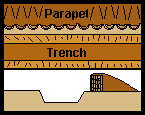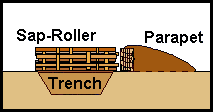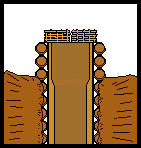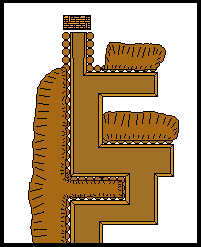Civil War Field Fortifications
Saps
Saps were particular types of trenches constructed in very
specific ways for the protection of troops on service in the approaches against
the point of attack of a besieged fortification. Saps were classified according
to their method of construction as outlined below.
Simple Sap
This was the easiest type of sap to construct and could
be accomplaished by working parties form of ordinary troops under direction
of sappers and engineer officers. A simple sap was constructed by throwing
the dirt excavated from the body of a trench forward on the side nearest
the enemy to form a parapet. A berme about one foot wide was left at the
base of the parapet to both keep the parapet from collapsing into the trench
and to form a banquette. The earth forming the parapet was not rammed and
the interior slope was not revetted unless the work was occupied for an extended
period of time or the nature of the soil required revetting to maintain its
form. The dimensions of a simple sap depended on the nature of the ground,
the position of the sap in relation to the fortification's columns of fire,
and the nature of traffic that would pass through the sap. Simple saps could
be as shallow as three feet and as narrow as ten feet or as much as eight
feet deep and twleve feet wide. The widest saps would be made to allow the passage of artillery
so that it could be hauled through the trench to the battery positions adjoining
the First or Second parallels. The First Parallel along with the boyaux leading
to it from the rear and extending from it to the Second Parallel were usually
constructed by means of the simple sap.
twleve feet wide. The widest saps would be made to allow the passage of artillery
so that it could be hauled through the trench to the battery positions adjoining
the First or Second parallels. The First Parallel along with the boyaux leading
to it from the rear and extending from it to the Second Parallel were usually
constructed by means of the simple sap.
Back to Siege Works
Flying Sap
 Flying
saps were used when it was necessary to place working parties under cover
as quickly as
Flying
saps were used when it was necessary to place working parties under cover
as quickly as
 possible or
when the slackness of enemy fire allowed the approaches to advance rapidly.
A flying sap was constructed by placing a number of gabions side by side
in a row and filling them all at the same time. Like the simple sap, a flying
sap could be constructed by ordinary working parties under the direction
of sappers and engineer officers. If the trench excavated behind the gabions
was to be turned into a parallel the flying sap could be arranged for defense
by construction of a banquette, if constructed for use as a boyaux, it would
be left without a banquette.
possible or
when the slackness of enemy fire allowed the approaches to advance rapidly.
A flying sap was constructed by placing a number of gabions side by side
in a row and filling them all at the same time. Like the simple sap, a flying
sap could be constructed by ordinary working parties under the direction
of sappers and engineer officers. If the trench excavated behind the gabions
was to be turned into a parallel the flying sap could be arranged for defense
by construction of a banquette, if constructed for use as a boyaux, it would
be left without a banquette.
Back to Siege Works
Full Sap
 Full
saps were employed when the approach trenches were within musket range of
the covered way of the point of attack. A full sap was constructed by teams
(called brigades) of eight specialist sappers who basically inched their
forward on their hands and knees under cover of a large sap-roller while
placing and filling one gabion at a time to advance the sap. This was dangerous
and tedious work that required a fair degree of experience and team work
to accomplish. British tests showed that four sappers working together required
15 minutes to place and fill one gabion and that the sap could be advanced
as much as 8'10" an hour. As the gabions were filled they were crowned with
fascines to bind them in place and dirt was thrown over and on top of the
fascines to form a parapet.
Full
saps were employed when the approach trenches were within musket range of
the covered way of the point of attack. A full sap was constructed by teams
(called brigades) of eight specialist sappers who basically inched their
forward on their hands and knees under cover of a large sap-roller while
placing and filling one gabion at a time to advance the sap. This was dangerous
and tedious work that required a fair degree of experience and team work
to accomplish. British tests showed that four sappers working together required
15 minutes to place and fill one gabion and that the sap could be advanced
as much as 8'10" an hour. As the gabions were filled they were crowned with
fascines to bind them in place and dirt was thrown over and on top of the
fascines to form a parapet.
Note: A full sap with gabions placed on one side of the
trench was sometimes referred to as a simple sap in contradistinction to
a double sap, which had gabions placed on both sides of the trench.
Back to Siege Works
Half Full Sap
A half full sap was constructed in the same way as a full
sap by sappers working in four man brigades placing one gabion at a time,
but without the cover of a sap-roller. The half full sap could be used when
the head of the sap was not directly threatened by enemy fire. Demi-parallels
run outward from the boyaux between the Second and Third parallels could
usually be constructed by means of the half full sap.
Double Sap
A double sap was used when the approach trench was threatened
by enemy fire from both flanks. Two brigades of sappers worked side by side
under cover of two sap-rollers to plant their gabions one at time on both
sides of the trench.
 Constructing
a double sap was even more tedious and time consuming than the full sap since
the two teams had to work in close proximity to each other and had to coordinate
their activities so that both sap-rollers could be advanced at the same time
without uncovering the head of the sap and exposing the sappers to enemy
fire. Because of the difficulties involved in trying to alter the direction
of two sap-rollers, double saps were usually directed along a straight line
rather than in a zig-zag pattern. Traverses, which could either be placed
on alternating sides of the trench or left in the center of the trench, had
to be constructed at intervals to defilade the trench from enemy fire. When
constructing traverses in the center of the sap the brigades on either side
of the double sap worked independently of each other to reach the far side
of the traverse where they had to rejoin and connect their sap-rollers to
continue the sap. The high degree of coordination necessary for the brigades
to complete their independent tasks almost always involved a loss of time
when one brigade worked slower than the other, forcing the other to wait
until the slower brigade finished its half of the traverse.
Constructing
a double sap was even more tedious and time consuming than the full sap since
the two teams had to work in close proximity to each other and had to coordinate
their activities so that both sap-rollers could be advanced at the same time
without uncovering the head of the sap and exposing the sappers to enemy
fire. Because of the difficulties involved in trying to alter the direction
of two sap-rollers, double saps were usually directed along a straight line
rather than in a zig-zag pattern. Traverses, which could either be placed
on alternating sides of the trench or left in the center of the trench, had
to be constructed at intervals to defilade the trench from enemy fire. When
constructing traverses in the center of the sap the brigades on either side
of the double sap worked independently of each other to reach the far side
of the traverse where they had to rejoin and connect their sap-rollers to
continue the sap. The high degree of coordination necessary for the brigades
to complete their independent tasks almost always involved a loss of time
when one brigade worked slower than the other, forcing the other to wait
until the slower brigade finished its half of the traverse.
Half Double
Sap
 The
half double sap was used when one side of a double sap was on significantly
lower ground than the other, allowing enemy fire to pass over one side of
the trench and strike the rear of the opposite parapet. A half double sap
was advanced by one brigade of sappers behind one sap-roller with provisional
gabions filled with sandbags placed on the low side of the trench. As the
sappers worked their slowly forward, reserves followed behind forming traverses
that branched out of the low side of the trench by removing the provisional
sand bag filled gabions at intervals, placing them on the side of the branch
trenches nearest the enemy, and throwing up parapets that were perpendicular
to the general direction of the sap. These traverses allowed ordinary working
parties to expand the trench to its full size while increasing the dimensions
of the traverses and finishing the parapets around the outside of the
perpendicular traverses. The rear of the high side parapet was thus defiladed
by increasing the amount of soil excavated from the sap, using the extra
soil to form more parapets and altering the direction of the parapets
on the low side to intercept enemy fire.
The
half double sap was used when one side of a double sap was on significantly
lower ground than the other, allowing enemy fire to pass over one side of
the trench and strike the rear of the opposite parapet. A half double sap
was advanced by one brigade of sappers behind one sap-roller with provisional
gabions filled with sandbags placed on the low side of the trench. As the
sappers worked their slowly forward, reserves followed behind forming traverses
that branched out of the low side of the trench by removing the provisional
sand bag filled gabions at intervals, placing them on the side of the branch
trenches nearest the enemy, and throwing up parapets that were perpendicular
to the general direction of the sap. These traverses allowed ordinary working
parties to expand the trench to its full size while increasing the dimensions
of the traverses and finishing the parapets around the outside of the
perpendicular traverses. The rear of the high side parapet was thus defiladed
by increasing the amount of soil excavated from the sap, using the extra
soil to form more parapets and altering the direction of the parapets
on the low side to intercept enemy fire.
Back to Siege Works
Contents
Major Works
Minor Works
Glossary
Parallels
Lines of Circumvallation and
Countervallation Mortar
Batteries Trench
Cavalier
Copyright (c) PEMcDuffie 1998
 twleve feet wide. The widest saps would be made to allow the passage of artillery
so that it could be hauled through the trench to the battery positions adjoining
the First or Second parallels. The First Parallel along with the boyaux leading
to it from the rear and extending from it to the Second Parallel were usually
constructed by means of the simple sap.
twleve feet wide. The widest saps would be made to allow the passage of artillery
so that it could be hauled through the trench to the battery positions adjoining
the First or Second parallels. The First Parallel along with the boyaux leading
to it from the rear and extending from it to the Second Parallel were usually
constructed by means of the simple sap.
 Flying
saps were used when it was necessary to place working parties under cover
as quickly as
Flying
saps were used when it was necessary to place working parties under cover
as quickly as
 possible or
when the slackness of enemy fire allowed the approaches to advance rapidly.
A flying sap was constructed by placing a number of gabions side by side
in a row and filling them all at the same time. Like the simple sap, a flying
sap could be constructed by ordinary working parties under the direction
of sappers and engineer officers. If the trench excavated behind the gabions
was to be turned into a parallel the flying sap could be arranged for defense
by construction of a banquette, if constructed for use as a boyaux, it would
be left without a banquette.
possible or
when the slackness of enemy fire allowed the approaches to advance rapidly.
A flying sap was constructed by placing a number of gabions side by side
in a row and filling them all at the same time. Like the simple sap, a flying
sap could be constructed by ordinary working parties under the direction
of sappers and engineer officers. If the trench excavated behind the gabions
was to be turned into a parallel the flying sap could be arranged for defense
by construction of a banquette, if constructed for use as a boyaux, it would
be left without a banquette.
 Full
saps were employed when the approach trenches were within musket range of
the covered way of the point of attack. A full sap was constructed by teams
(called brigades) of eight specialist sappers who basically inched their
forward on their hands and knees under cover of a large sap-roller while
placing and filling one gabion at a time to advance the sap. This was dangerous
and tedious work that required a fair degree of experience and team work
to accomplish. British tests showed that four sappers working together required
15 minutes to place and fill one gabion and that the sap could be advanced
as much as 8'10" an hour. As the gabions were filled they were crowned with
fascines to bind them in place and dirt was thrown over and on top of the
fascines to form a parapet.
Full
saps were employed when the approach trenches were within musket range of
the covered way of the point of attack. A full sap was constructed by teams
(called brigades) of eight specialist sappers who basically inched their
forward on their hands and knees under cover of a large sap-roller while
placing and filling one gabion at a time to advance the sap. This was dangerous
and tedious work that required a fair degree of experience and team work
to accomplish. British tests showed that four sappers working together required
15 minutes to place and fill one gabion and that the sap could be advanced
as much as 8'10" an hour. As the gabions were filled they were crowned with
fascines to bind them in place and dirt was thrown over and on top of the
fascines to form a parapet.
 Constructing
a double sap was even more tedious and time consuming than the full sap since
the two teams had to work in close proximity to each other and had to coordinate
their activities so that both sap-rollers could be advanced at the same time
without uncovering the head of the sap and exposing the sappers to enemy
fire. Because of the difficulties involved in trying to alter the direction
of two sap-rollers, double saps were usually directed along a straight line
rather than in a zig-zag pattern. Traverses, which could either be placed
on alternating sides of the trench or left in the center of the trench, had
to be constructed at intervals to defilade the trench from enemy fire. When
constructing traverses in the center of the sap the brigades on either side
of the double sap worked independently of each other to reach the far side
of the traverse where they had to rejoin and connect their sap-rollers to
continue the sap. The high degree of coordination necessary for the brigades
to complete their independent tasks almost always involved a loss of time
when one brigade worked slower than the other, forcing the other to wait
until the slower brigade finished its half of the traverse.
Constructing
a double sap was even more tedious and time consuming than the full sap since
the two teams had to work in close proximity to each other and had to coordinate
their activities so that both sap-rollers could be advanced at the same time
without uncovering the head of the sap and exposing the sappers to enemy
fire. Because of the difficulties involved in trying to alter the direction
of two sap-rollers, double saps were usually directed along a straight line
rather than in a zig-zag pattern. Traverses, which could either be placed
on alternating sides of the trench or left in the center of the trench, had
to be constructed at intervals to defilade the trench from enemy fire. When
constructing traverses in the center of the sap the brigades on either side
of the double sap worked independently of each other to reach the far side
of the traverse where they had to rejoin and connect their sap-rollers to
continue the sap. The high degree of coordination necessary for the brigades
to complete their independent tasks almost always involved a loss of time
when one brigade worked slower than the other, forcing the other to wait
until the slower brigade finished its half of the traverse.
 The
half double sap was used when one side of a double sap was on significantly
lower ground than the other, allowing enemy fire to pass over one side of
the trench and strike the rear of the opposite parapet. A half double sap
was advanced by one brigade of sappers behind one sap-roller with provisional
gabions filled with sandbags placed on the low side of the trench. As the
sappers worked their slowly forward, reserves followed behind forming traverses
that branched out of the low side of the trench by removing the provisional
sand bag filled gabions at intervals, placing them on the side of the branch
trenches nearest the enemy, and throwing up parapets that were perpendicular
to the general direction of the sap. These traverses allowed ordinary working
parties to expand the trench to its full size while increasing the dimensions
of the traverses and finishing the parapets around the outside of the
perpendicular traverses. The rear of the high side parapet was thus defiladed
by increasing the amount of soil excavated from the sap, using the extra
soil to form more parapets and altering the direction of the parapets
on the low side to intercept enemy fire.
The
half double sap was used when one side of a double sap was on significantly
lower ground than the other, allowing enemy fire to pass over one side of
the trench and strike the rear of the opposite parapet. A half double sap
was advanced by one brigade of sappers behind one sap-roller with provisional
gabions filled with sandbags placed on the low side of the trench. As the
sappers worked their slowly forward, reserves followed behind forming traverses
that branched out of the low side of the trench by removing the provisional
sand bag filled gabions at intervals, placing them on the side of the branch
trenches nearest the enemy, and throwing up parapets that were perpendicular
to the general direction of the sap. These traverses allowed ordinary working
parties to expand the trench to its full size while increasing the dimensions
of the traverses and finishing the parapets around the outside of the
perpendicular traverses. The rear of the high side parapet was thus defiladed
by increasing the amount of soil excavated from the sap, using the extra
soil to form more parapets and altering the direction of the parapets
on the low side to intercept enemy fire.